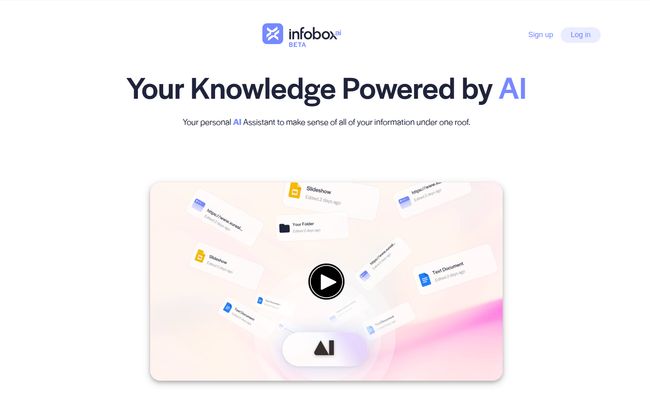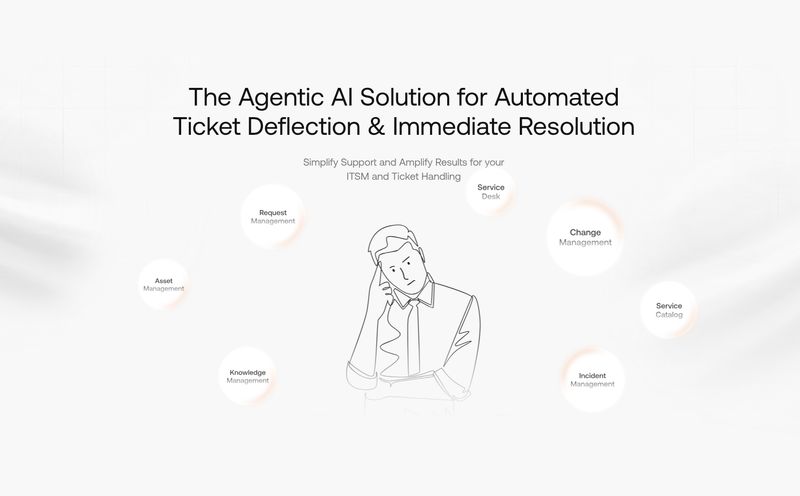Every company I've ever worked with, from scrappy startups to behemoth corporations, has the same dirty little secret. Their information is a complete and utter mess. We talk a big game about having a "single source of truth," but the reality is a chaotic sprawl of Google Drive graveyards, forgotten Confluence pages, and Slack channels that are black holes of critical information.
Finding that one specific piece of data you need right now feels less like a search and more like an archaeological dig. And honestly who has time for that?
For the last couple of years, the AI boom has promised to solve everything. But most of the off-the-shelf AI tools are trained on the whole wide internet. They're great at writing a poem about a cat in the style of Shakespeare, but ask them about your company's specific Q3 sales process, and they'll just stare back at you blankly. The real magic, the stuff that actually moves the needle, comes from training an AI on your own data. Your knowledge. Your expertise.
That's where a tool like Infobox.ai comes into the picture. It's making some pretty bold claims about letting you build a personal AI assistant, and as someone who lives and breathes this stuff, I had to take a closer look.
What Exactly is Infobox.ai? A Quick Rundown.
So, what is this thing? In the simplest terms, Infobox.ai is a platform that lets you create a custom AI assistant and feed it your own, private information. Think of it like hiring a brilliant, tireless new employee and giving them a PhD in your business on their first day. Their tagline is "Your Knowledge Powered by AI," and that's a pretty spot-on description.
The whole idea is to take all that scattered information—product docs, support tickets, internal policies, meeting notes—and consolidate it into one intelligent, searchable brain that you, your team, or even your customers can interact with. It's about turning data chaos into a conversation.
The Core Experience of Building Your Own AI
I’m always skeptical of tools that promise simplicity, because it usually means they lack power. But the process outlined by Infobox seems refreshingly straightforward. It boils down to three main phases.
Feeding the Machine: Getting Your Data In
First, you have to train your AI. This is the foundational step. Infobox allows you to pull in content from all the usual suspects: you can upload files directly, paste in web links to documentation or blog posts, or—and this is the important part—integrate with the apps you already use. The images show connections to Google Drive, which is a big one. Pumping in your existing documents, spreadsheets, and presentations is the fastest way to make the AI genuinely useful. It’s where the raw knowledge lives.
Now, let's be realistic. This is the part that takes some initial effort. The AI is only going to be as smart as the data you give it. Remember the old programmer's mantra? Garbage In, Garbage Out. You’ll need to be thoughtful about what you feed it, but this upfront investment is what separates a gimmick from a game-changing tool.
Making It Yours: The Fun of Customization
Once your AI is learning, you can customize its appearance. The interface lets you change the widget's icon, color scheme, and style to match your brand. This might seem like a small cosmetic feature, but it’s psychologically important. It makes the AI feel like a part of your company, not some generic third-party bolt-on. It builds trust, both for your internal team and for any customers who might interact with it.
Unleashing Your AI: Collaboration and Sharing
This is where it gets really interesting. An AI brain that only you can access is cool, but an AI brain you can share with your entire team is transformative. You can embed your newly trained assistant on your website as a customer support bot, share it with your sales team so they can get instant answers on product specs, or use it internally to help onboard new hires. This collaborative aspect is what elevates it from a personal productivity hack to a genuine business asset.

Visit Infobox.ai
Putting It to Work: Real-World Scenarios
Okay, the theory is nice. But how would you actually use this day-to-day? The site gives a few examples, and my mind is already racing with possibilities.
- Streamlined Customer Support: Imagine a support chatbot that actually helps. One that's been trained on every single one of your help-desk articles, technical manuals, and past support tickets. It could answer most questions instantly, freeing up your human agents to handle the really tricky issues. This could be a huge win for both customer satisfaction and operational costs.
- Simplified Data Analysis: This one's intriguing. The idea is to empower anyone to get insights from business data without needing to be a spreadsheet wizard. You could theoretically ask in plain English, "What were the key takeaways from our last user feedback report?" and get a coherent summary. That's a powerful proposition.
- Internal Knowledge Sharing: For me, this is the holy grail. Think about it. No more tapping a colleague on the shoulder to ask, "Hey, where's that policy on expense reports again?" New employees could ask the AI about company culture, processes, or project histories. It’s the ultimate antidote to information hoarding and institutional knowledge walking out the door when someone leaves.
The Grown-Up Stuff: Integrations and Data Security
Any tool that wants to be the central brain of a company has to address two major concerns: how well does it connect to everything else, and can you trust it with your secrets?
Does It Play Well with Others?
A tool is only as good as its ability to fit into your existing workflow. The logos on the Infobox site are reassuring: Google, Microsoft, HubSpot, Slack. These are the big ones. Integrating with Google Drive and Slack alone covers a huge chunk of most companies' daily operations. While the full extent of their integration library isn't detailed, focusing on these core platforms is a smart move. It shows they understand where work actually happens.
A Word on Data Privacy (Because It Matters A Lot)
Handing over all your company's proprietary data to a third-party AI is, frankly, terrifying. This is probably the biggest hurdle for any business considering a tool like this. Infobox seems to get it. They proactively mention compliance with major data protection regulations like GDPR, CCPA, and HIPAA. This isn't just a footnote; it's a critical feature. It suggests they've built their platform with a security-first mindset. Your knowledge base is treated like a private, secure vault, not a public library for the AI model to learn from indiscriminately. For any business in healthcare, finance, or just Europe in general, this is a non-negotiable starting point.
So, What's the Catch? A Realistic Look
No tool is perfect, and from my experience, the shiny landing page always hides a few practical realities. One of the cons I can see is the initial setup. Training the AI requires effort. You can't just point it at a messy, disorganized folder and expect miracles. You’ll need to curate your data, and that takes time. But then again, maybe that forced spring-cleaning of your digital house is a benefit in itself.
The other potential issue is the scope of integrations. While they list the big players, a company with a more obscure or specialized tech stack might find a missing link. It’s always a trade-off between a tool that does one thing incredibly well versus one that tries to connect to everything and masters nothing.
The Million-Dollar Question: Infobox.ai Pricing
Ah, the pricing page. Or, in this case, the lack thereof. There's no public pricing grid, which is typical for B2B or enterprise-grade software. Instead, you'll find a friendly invitation: "Need a tailor-made AI Assistant for your unique business needs? Let's talk."
Don't let this scare you off. This usually means they don't have a one-size-fits-all solution. The needs of a 10-person agency are vastly different from a 1,000-person corporation. A consultative approach allows them to understand your specific use case, data volume, and integration needs before giving you a quote. It's less about hiding the price and more about selling a solution, not just a product.
My Final Take: Is Infobox.ai Worth a Look?
After digging through everything, I'm genuinely optimistic. Infobox.ai seems to be targeting a very real, very painful problem for modern businesses. We are all drowning in our own data, and the promise of an intelligent assistant that can make sense of it all is incredibly compelling.
Is it for everyone? Probably not. If you're a solo freelancer, this might be overkill. But if you're part of a team—especially in customer support, sales, or HR—or you run a business where institutional knowledge is your main asset, then yes. I think it's absolutely worth starting a conversation with them. The potential to save hundreds of hours of wasted search time and make your entire organization smarter is just too significant to ignore.
Frequently Asked Questions about Infobox.ai
What is Infobox.ai used for?
Infobox.ai is primarily used to create a personal or business AI assistant trained on your own private data. Key use cases include improving customer support with intelligent chatbots, simplifying internal knowledge sharing for teams, and enabling easier data analysis through natural language questions.
How does Infobox.ai learn from my data?
You train your AI assistant by providing it with information. You can do this by uploading documents, adding web links to existing online content, or integrating the platform with apps like Google Drive where your information is already stored. The AI processes this content to build its knowledge base.
Is my data safe with Infobox.ai?
Data security appears to be a major focus. The platform highlights its proactive data protection measures and compliance with standards like GDPR, CCPA, and HIPAA, which is crucial for businesses handling sensitive information.
Can I customize the look of my AI assistant?
Yes. Infobox.ai provides options to customize the appearance of the AI assistant widget, including its icon, color, and style, allowing you to align it with your company's branding.
Who is the ideal user for Infobox.ai?
The ideal user is likely a small to large business or a team within an organization that struggles with managing and accessing a large volume of internal information. This includes customer support teams, sales departments, HR, and any company where proprietary knowledge is a key asset.
Is there a free trial for Infobox.ai?
The website does not explicitly mention a free trial. Given its custom, B2B-focused approach, a trial or demo would likely be part of the initial consultation process after you reach out through their "Let's talk" contact form.
Conclusion
The way we work is defined by the tools we use, and for decades, we've been stuck with digital filing cabinets. Infobox.ai represents a shift toward a more intelligent, conversational way of interacting with our own collective knowledge. It's an ambitious goal, but from what I can see, they've built a thoughtful and powerful platform to make it happen. If you're tired of the endless searching and ready to put your company's data to work, this is a space worth watching very, very closely.



